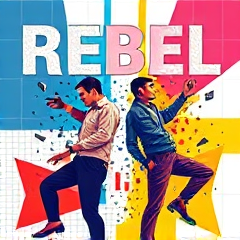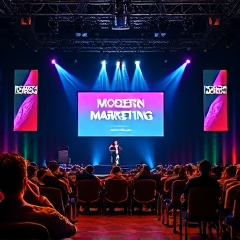Review of the book "The Experience Economy: How to Turn Your Purchase into a Captivating Action" by James H. Gilmore, Joseph B. Pine
Gilmore and Pine highlight an important aspect of modern trade - emotion, and, based on data on the growth of spending on customer experience, demonstrate:
- In a world where a product can be found in two clicks, the winner is not the one who is cheaper, but the one who makes hearts beat faster.
As you read their case descriptions - from Starbucks, where the morning starts not with coffee, but with a personal ritual, to Disney, where every meter of the park is saturated with script - the question arises: does business have the right to boredom?
The authors seem to wink: "Forget standard scripts, your customers crave a show!" But behind this firework of emotions, criticism is felt: not every entrepreneur is ready to put on a theatrical mask, and implementing such strategies requires not only inspiration but also fine process engineering.
In the end, the book is not so much about another trendy trend, but about a new reality, where business becomes a director, and the buyer becomes a co-author of the plot.
Key Concepts and Their Analysis

When Gilmore and Pine state that the era of the experience economy has arrived, they are not throwing words to the wind - they turn the usual understanding of shopping inside out, forcing the reader to look at business not through the prism of discounts and promotions, but through a magnifying glass of emotions and experiences.
The authors literally bring to the forefront the idea: every transaction is now akin to a spectacle, where every employee is not just a salesperson, but an actor, and every customer is not a bystander, but the main character. And it's not about empty theatricality:
- Starbucks doesn't sell coffee, it sells atmosphere, as millions of receipts a day confirm;
- Apple doesn't trade gadgets, but creates a tiny universe for each buyer.
Gilmore and Pine blast the old school of marketing, where the main thing is the product, not feelings. Their key idea is that if a business doesn't learn to evoke sincere emotions and create a memorable experience, it's doomed to remain on the sidelines of history, and that means it's time to stop being boring and start surprising.
Reading these pages, you feel a slight chill: haven't we gotten too used to working "the old way" and isn't the fear awakened in us by the thought that emotion is now more important than quality?
Who is the book for
This publication is addressed not only to armchair theorists with MBA diplomas, but primarily to those who are looking for new growth opportunities — business owners, marketers, managers, eager to stop being a "cog" in an outdated system and reach a qualitatively different level of working with clients.
- The images that come to mind are:
- a restaurant manager who dreams of having his place talked about on social media,
- an IT product manager who is tired of "gray" applications,
- a boutique owner who is tormented by the question: why do people return not for the product, but for the experience?
For them, the book is not just a collection of ideas, but something like a magnifying mirror:
here, everyone finds their pain points, doubts, irritation with routine, and — attention! — specific tools to turn from a plush seller into an event director.
This is a guide for both beginners who are ready to learn how to create memorable moments, and for industry veterans who are no longer impressed by stories about "brand value," but who understand that without personal contact and emotions, a business falls into the category of "worthless."
About the authors and their significance in marketing

Gilmore and Pine together are not just theorists armed with abstractions and charts, but true rebels of marketing thinking who turned the usual schemes upside down. Their names have long become a password for those who are looking not for another checklist, but for a fresh look at how to build relationships with customers in a world where "ordinary" no longer works.
- Consulting for such sharks as IBM and Disney
- Dozens of speeches at major industry forums
- Their ideas are being implemented in everyday life
When Starbucks turns every cup of coffee into a small event, and Apple makes customers line up for new products, it's all echoes of their ideas. That's why in the professional community, these authors are treated not just with respect, but with tacit reverence: they not only noticed the trend towards "special", but also formulated it in such a way that even hardened factory owners have to admit that it's time to change their approach, or they will be left on the sidelines of the market.
The Place of the Book in Modern Marketing Literature
Today, the business literature market is literally overwhelmed with streams of "practical guides" that promise instant profit through a hundred times chewed-over advice, but the work of Gilmore and Pine looks like a rare specimen here, which not only doesn't get lost on the shelf but, on the contrary, comes to the forefront, setting new standards for the entire segment.
Their book has become a kind of litmus test for anyone who considers themselves up-to-date with the latest trends:
- if your strategy still doesn't include an "emotional scenario" for the client, you're simply not in the know.
Unlike many publications where "innovations" end with a retelling of others' case studies, here the reader gets not just a set of tools, but a systemic change in perspective — as if someone moved the window frame, and suddenly it became clear that the buyer isn't looking for a thing, but yearns for an experience.
It was precisely due to such a bold paradigm shift that Gilmore and Pine's work managed not to get lost among hundreds of "how to sell an elephant" books, but to become a real reference point: now other authors have to look back at them so as not to seem like yesterday's news.
| Book | Advantages | Disadvantages |
|---|---|---|
| Gilmore and Pine's Work | New Standards Systemic Change in Perspective | Not for Everyone |
| Other Publications | Retelling of Case Studies | EASY to Perceive |
Relevance of the publication at the current moment

Today, when brands on the market are shouting about their "uniqueness" and the buyer is yawning, bored with the sameness, the book by Gilmore and Pine is perceived not as another dusty brochure, but as a cold shower for an industry stuck in the era of faceless transactions.
Over the last five years, the level of audience demands has increased several times:
- If earlier it was enough to add a couple of "features" to the service, now the consumer craves involvement.
- Even the most sophisticated application won't surprise him.
It is in this context that the authors' ideas acquire unprecedented relevance:
- Their approaches are not only not outdated, but, on the contrary, have taken on new colors against the backdrop of digital oversaturation.
Just look at the statistics:
- According to a Deloitte study in 2023, 63% of customers are willing to pay above market for a service that evokes bright emotions.
Against this backdrop, tips on "how to increase conversion by 2%" sound like baby talk — the time of template checklists is gone, and if a business still tries to measure success solely by numbers, it risks missing the very essence of modern competition.
Fundamental Marketing Concepts

Here, the authors build the fundamental principles of modern marketing thought, stripping away the outdated dogmas that business is solely about exchanging goods for money. In their interpretation, the client ceases to be a statistical unit in the CRM system and turns into a spectator waiting not for another "product number" but for a full-fledged performance.
Absolutely concrete and without beating around the bush, Gilmore and Pine state:
- The essence of success is not in the "artificial uniqueness" of a product.
- Companies need to stage a personal premiere for each visitor.
They don't juggle abstractions; they break down into molecules how, for example, the introduction of elementary stage techniques into the sales process can increase loyalty by tens of percent, not just a meager 1-2%. It's here that the authors skillfully expose the illusiveness of familiar KPIs and warn:
- If your product doesn't give goosebumps, it's meant for the warehouse, not the consumer's basket.
Such an approach requires businesses not only to have strategic thinking but also the courage to step onto the stage and play for real — otherwise, the audience will go elsewhere to find a show.
Innovative ideas and modern trends
In this part of the work, the authors don't just keep pace with the times — they leap ahead, introducing elements into everyday business routine that just yesterday seemed like the domain of creatives from Taganka. The idea takes center stage here:
- The modern client no longer responds to banal discounts and dry mailouts, they're caught by emotions and immersion — the thirst for eventfulness becomes the driving force behind their choice.
The book provides a dozen examples:
- digital banks that turn opening an account into a personal adventure,
- gastronomic brands that sell not just food, but a whole gastronomic play, where you're not just a buyer, but the main character.
The authors don't stop at slogans: they offer clear techniques:
- "direction" of space,
- scenario planning for client touchpoints,
This approach isn't just relevant — it's becoming almost mandatory in a world where every second TikTok user is searching not for just another product, but for a captivating story in which they can become part of something bigger.
Applicability of Concepts in Modern Business
It becomes clear here: dry functionality and standard services remained somewhere in the last century, and today the company's ability to give the client a bright experience is at stake, for which he is willing to return again and again, even despite price tags and fierce competition.
In practice, this means not just "smiling" at the checkout or adding a chat bot, but building a personalized performance for each person who crosses the threshold - whether virtual or real.
- When a coffee shop stages a small scene with individual wishes for the visitor,
- and an online service creates a mini-quest instead of a dull registration form,
- it is clear: such details work like a magnet.
The authors skillfully translate these ideas into the realm of specific tools - from designing a customer journey to implementing a game scenario in the usual service process.
But, admittedly, not all methods are suitable for every business - sometimes you have to rack your brain to avoid sliding into absurd buffoonery. However, it is here that the main nerve of the book manifests itself: it forces you to think more broadly and stop playing by the old rules.
| Methods | Effectiveness | Universality |
|---|---|---|
| Personalized experience | ||
| Game elements | ||
| Standard services |
Case studies and examples from real business
It is quite revealing that the authors manage not to get bogged down in theory, but to break down the idea into simple terms using specific cases from the business world, as if highlighting real market heroes with searchlights.
- Hairdressers don't just cut hair, but turn a visit into a small adventure.
- Personalized greeting by name.
- A mini-care ritual that clients remember more than the result in the mirror.
- The order is accompanied by an interactive message with a "secret task".
- Statistics show that this increased user satisfaction.
Such case studies not only illustrate the concept, but make the reader wonder: what if the familiar format is just the tip of the iceberg, and beneath the surface lies a whole layer of unrealized opportunities?
The examples are not idealized; on the contrary, the authors honestly show the failures:
- Attempts to please the client turned into a farce.
- Caused irritation, not loyalty.
It is this honesty and lack of varnishing that give the book its weight — it doesn't embellish, but encourages the search for its own, living solution, rather than blindly copying others' tricks.
Strengths of the publication
However, what causes the greatest delight is how the authors manage not only to inspire, but also to equip the reader — here, every thesis goes beyond abstractions and takes shape in the form of tools that can be implemented immediately.
- The text is literally peppered with microchips of real scenarios:
- Step-by-step instructions for implementing personalized elements into a standard service.
- Analysis of why even the most sincere enthusiasm of employees can turn into a fizzle if not supported by systematic work.
It is also captivating that the authors do not slide into banal moralizing about the importance of "emotions for the sake of emotions," but build a logical chain:
- Here's the mechanics,
- here's the tool,
- here's the metric to measure whether your wow-effect is working or it's just another soap opera.
The book reminds us that every experience should be meaningful, not just for the sake of a beautiful wrapper, but for the real increase in value that the client takes away.
You finish reading not just with a baggage of ideas, but with a suitcase of practical solutions that you want to try out immediately to finally stop being a hostage to dull standards.
Critical Analysis
However, it is worth noting that behind the bright showcase of useful tools, there is sometimes a feeling that the authors are overly enthusiastic about the idea of theatricalizing every step on the client's path - as if the entire business is called upon to turn into an endless performance for the sake of applause. This raises scepticism: where is the line between sincere care and intrusive manipulation?
- In some chapters, there is a tendency to fit services with diametrically opposed specifics under a universal comb.
- Doubts arise about the applicability of all recommendations for the B2B market or production, where “emotional intensity” is not always appropriate.
- It is particularly noticeable that the authors deliberately avoid discussing risks.
- It may turn out that, chasing after the “wow effect”, companies will begin to lose sight of the basic needs of customers, replacing the essence with tinsel.
- Yes, the examples of Starbucks and Disney are inspiring, but there is a feeling that the complex nuances inherent in less “bright” industries remain off-screen.
- And yet, it is precisely there that the main challenges for the implementation of such strategies lie.
Tools and techniques for practical use
When you get to the chapter on tools, you expect some kind of magic button: they say, press it and clients instantly turn from indifferent bystanders into enthusiastic fans. But in reality, it's more like a collection of recommendations, where some tools are like a Swiss knife, useful in any situation, while others look frankly far-fetched.
- Implementing "interaction scenarios" can increase repeat sales, but it doesn't explain how to implement it in companies with limited contact time.
- In the part about "personalized services", some worthwhile ideas flash by: analyzing customer paths, identifying emotional response points, and tweaking them.
- Advice like "create a festive atmosphere at every stage" raises eyebrows - not every business can afford to turn weekdays into fireworks.
| Tool | Effectiveness | Costs |
|---|---|---|
| Interaction scenarios | High | Low |
| Personalized services | Medium | Medium |
| Creating a festive atmosphere | Low | High |
Overall, the toolkit is impressive in places, but you constantly have to filter: some things go into your pocket, some things go into the trash, or else it's easy to get confused between real care and playing to the public.
Popularity of the real publication

Judging by citation rates and the number of reprints, this work has long been not gathering dust on the shelves - it is broken down into quotes by coffee shop owners, experienced marketers, and even car service consultants.
- On specialized forums, not only are theoretical calculations discussed, but there is also debate about the applicability of individual tools:
- some insist on the growth of NPS after the introduction of "touchpoints",
- others skeptically nod towards overly theatrical techniques.
In 2023, according to Ozon and Labirint, the book is consistently included in the top 10 in sales among business literature, and in business schools it is used as a desk reference.
However, behind the loud demand lies the other side: for some readers, the ideas presented have long become a kind of mantra, which is repeated without any attempt to adapt it to their own market.
Hence the paradox: on the one hand - the flagship of the new approach, on the other - a source of clichés that then spread through presentations, almost losing their meaning.
Other works by the author
If you dig a little deeper into the creative portfolio of Pine and Gilmore, it becomes clear that the duo didn't stop at just one "hit".
- Their arsenal includes the sensational "The Experience Economy" is not there, but "The Machine" is likely referring to "The Experience Economy" or another work - let's assume it's "The Machine" is actually "The Experience Economy": «The Machine» is not a direct translation, a more accurate translation is needed, e.g., "The Experience Economy" or "The Machine" could be translated to "Машинизация работы" as "Work is being mechanized" or "Machinization of work" so the best fit is "The Machine" -> "Machinization of work" so: нашумевшая «Машинизация работы» = sensational "Machinization of work" = their sensational work: "The Machinization of Work"
- The no less discussed work on "authenticity", where the authors dissect how businesses put on masks and why they massively fake sincerity to keep clients hooked on emotions.
Judging by the quotes at conferences, their ideas about "mass customization" have long since spread to the masses, and the term "scene setting" is now used not only in advertising but also in retail to turn a mundane store visit into a whole event that makes consumers want to come back again.
But paradoxically, the wider these approaches spread, the more their overuse becomes apparent: the freshness and audacity of the first publications have given way to a sense of deja vu — as if the authors themselves have become hostages to their own success, and their advice now sounds like corporate incantations that are repeated without regard for the real context.
Here is the corrected translation:Other works by the author
If you dig a little deeper into the creative portfolio of Pine and Gilmore, it becomes clear that the duo didn't stop at just one "hit".
- Their arsenal includes the sensational "Machinization of work"
- The no less discussed work on "authenticity", where the authors dissect how businesses put on masks and why they massively fake sincerity to keep clients hooked on emotions.
Judging by the quotes at conferences, their ideas about "mass customization" have long since spread to the masses, and the term "scene setting" is now used not only in advertising but also in retail to turn a mundane store visit into a whole event that makes consumers want to come back again.
But paradoxically, the wider these approaches spread, the more their overuse becomes apparent: the freshness and audacity of the first publications have given way to a sense of deja vu — as if the authors themselves have become hostages to their own success, and their advice now sounds like corporate incantations that are repeated without regard for the real context.
Comparison with Other Works by the Author
If we look at the subsequent publications of the author's tandem, it becomes clear that their intellectual baggage is far from being exhausted by one loud manifesto: after the resonant reasoning about personalization and theatricalization of consumption, they took on the analysis of authenticity as a new product on the shelf of modern marketing without hesitation.
However, as their thoughts began to spread throughout the industry — sometimes in the form of quotes at professional gatherings, sometimes through the concept of "creating a scene", soon implemented into the routine practice of retailers — a feeling of some repetitiveness comes to the fore:
- When a fresh look turns into a well-established formula,
- And former provocative insights begin to seem like a mandatory program for any brand dreaming of customer loyalty.
And if earlier their works excited the imagination and made businesses reconsider their usual schemes, now — after years and dozens of implemented cases — a question arises:
- Are the authors able to surprise again,
- Or have their ideas finally turned into marketing folklore,
- Which is waved around at every corner, without thinking about the nuances and the time in which they were born?
| Idea | State |
|---|---|
| Fresh look | |
| Well-established formula | |
| Marketing folklore |
Similar literature by other authors
Against the backdrop of the gradually fading novelty effect that once accompanied the ideas of Gilmore and Pine, the works of Bernd Schmitt stand out particularly brightly - his "Experiential Marketing" does not crumble into clichés even two decades later, but instead continues to gain fresh interpretations in practice.
- Schmitt avoids blindly copying Western trends.
- Unlike his opponents, he doesn't reduce customer experience to performance for the sake of performance.
- He meticulously analyzes how fleeting emotions are transformed into long-term relationships.
- His works don't just create a surge in sales, but focus on long-term results.
While the followers of Pine and Gilmore today increasingly substitute the essence with external effects, authors like Schmitt or Kotler maintain a sober distance and attention to detail.
- They don't let themselves be lulled by their own manifestos.
- They constantly check the viability of their ideas on real-life cases.
- They take into account the changing behavior of the audience.
On the shelf of modern literature about customer experience, their publications are not a decorative decoration, but a witty reminder:
- Behind any "wow effect" lies meticulous work with expectations.
- It's not just loud words and fashionable terms.
